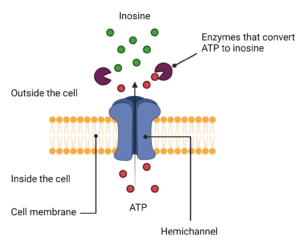 The CMT Research Foundation is partnering with the University of Illinois Chicago to test a potential therapeutic for CMT1X, the second most common form of CMT, behind only CMT1A in prevalence.
The CMT Research Foundation is partnering with the University of Illinois Chicago to test a potential therapeutic for CMT1X, the second most common form of CMT, behind only CMT1A in prevalence.
CMT is one of the most common inherited neurological disorders, affecting people across the globe. CMT1X is caused by mutations of the gap junction beta 1 (GJB1) gene. This gene contains the code for connexin 32, a protein that normally forms channels that allow ions and signaling molecules to pass between cells or from the inside of the cell to the external environment. However, mutations of the gene cause these proteins to become dysfunctional. Because these channels are normally found in Schwann cells, the cells that produce the myelin sheath in the peripheral nervous system, this leads to peripheral nerve dysfunction and degeneration. People with CMT1X-causing mutations experience loss of sensation and/or numbness in the legs and arms, muscle weakness and wasting, and foot deformities. Because CMT is progressive, patients continue to lose function as they age, creating a greater degree of disability. Currently, there is no cure or any effective treatment for this disorder.
This project, which is led by Dr. Charles Abrams, Professor of Neurology and Rehabilitation at the University of Illinois Chicago (UIC), will test whether treatment with inosine may ameliorate CMT1X symptoms or even change the course of the disease. Inosine is an anti-inflammatory small molecule, and its levels are reduced in animal models of CMT1X. It is hypothesized that lower inosine levels may play a role in the nerve inflammation seen in people with CMT1X and that raising inosine levels may have therapeutic benefit. This project will test these ideas, and if successful, will culminate in a trial of inosine therapy in mice with a genetic mutation that causes CMT1X.

Connexin 32 normally forms hemichannels in cell membranes. These hemichannels may allow ATP to leave the cell and be converted into the anti-inflammatory substance inosine. In CMT1X, this function may be disrupted due to mutations of GJB1, the gene that codes for connexin 32. (Illustration created with Biorender.)
“We are pleased to partner with Dr. Abrams and the University of Illinois Chicago to tackle this major form of CMT. With this launch, the CMT Research Foundation now has programs in all four of the major forms of CMT, along with several of the more rare types as well. This project is particularly exciting because it has the potential to provide evidence to support the further development inosine as a therapeutic, which could ultimately benefit the vast majority of people with CMT1X,” says Susan Ruediger, CEO of CMT Research Foundation.
Inosine is widely available as a supplement and is also being studied as a potential therapeutic for Parkinson’s disease and multiple sclerosis, two other degenerative diseases of the nervous system. However, the CMT Research Foundation cautions those with CMT about using inosine before more research is completed. Keith Fargo, Chief Scientific Officer of the foundation notes, “As a science-based organization, we do not recommend that people take supplements because they have not yet been tested in clinical trials, which is the only way to know whether they will be effective, let alone safe, for people with CMT.”
According to study lead Charles Abrams, MD, PhD, “As a physician, I see many patients with CMT1X, but at the current time there are no effective medications that I can prescribe for them. As a scientist, though, I am heartened by the progress being made in understanding biological processes underlying CMT. Part of that has been gaining new insights into how and why mutations of the GJB1 gene cause CMT, and a lot of the evidence is pointing to a role for GJB1 proteins in regulating the levels of important anti-inflammatory molecules such as inosine. This project will be the first to directly test whether raising inosine levels in a CMT1X animal model will improve outcomes.”
